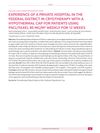Search
for
Sort by
Research
150-180 / 1000+ resultsresearch Scalp Hypothermia as a Preventative Measure for Chemotherapy-Induced Alopecia: A Review of Controlled Clinical Trials
Scalp cooling effectively reduces hair loss from chemotherapy.

research Chemotherapy-Induced Alopecia: Emotional Distress and Mitigation Strategies
Scalp cooling might reduce hair loss from chemotherapy, but evidence is weak and other treatments are being tested.
research Efficacy of Interventions for Prevention of Chemotherapy-Induced Alopecia: A Systematic Review and Meta-Analysis
Scalp cooling significantly reduces chemotherapy-induced hair loss.

research Treatment of Chemotherapy-Induced Alopecia
Scalp cooling can prevent chemotherapy-induced hair loss, and certain treatments can speed up hair regrowth, but more research is needed for better treatments.

research Chemotherapy-Induced Alopecia Management: Clinical Experience and Practical Advice
The conclusion is to use scalp cooling, gentle hair care, and treatments like minoxidil for managing hair loss from chemotherapy, and stresses the need for more research and collaboration in this area.

research Chemotherapy-Induced Alopecia
Many patients find hair loss from chemotherapy very distressing, and while treatments like minoxidil and scalp cooling may help, there is no sure way to prevent it.

research Therapeutic Strategies for Treating Hair Loss
The conclusion is that we need more effective hair loss treatments than the current ones, and these could include new drugs, gene and stem cell therapy, hormones, and scalp cooling, but they all need thorough safety testing.

research A Clinical and Biological Guide for Understanding Chemotherapy-Induced Alopecia and Its Prevention
Scalp cooling can help prevent chemotherapy-induced hair loss with a 50-90% success rate and is safe for patients.

research Pathogenesis and Treatment Options for Chemotherapy-Induced Alopecia: A Systematic Review
Scalp cooling is the most effective FDA-approved method to prevent chemotherapy-induced hair loss, but more research is needed for other treatments.

research Prevention and Treatment of Chemotherapy-Induced Alopecia
Scalp cooling can help prevent hair loss from chemotherapy, but treatment should be tailored to the individual and more research is needed.

research Chemotherapy-Induced Hair Loss: The Use of Biomarkers for Predicting Alopecic Severity and Treatment Efficacy
Scalp cooling to prevent hair loss from chemotherapy works for some but not all, and studying hair damage markers could improve prevention and treatment.

research An Overview of Management of Drug-Induced Hair and Nail Disorders
Cooling the scalp may prevent hair loss from chemotherapy, hair often grows back after treatment, and nail issues usually improve after stopping the drug.
research Targeted Therapy and Chemotherapy-Associated Skin Toxicities: Systematic Review and Meta-Analysis
Minocycline reduces acne rash, pyridoxine lowers hand-foot syndrome risk, and scalp cooling lessens hair loss from cancer treatments.

research Prevention and Treatment of Chemotherapy-Induced Alopecia: What Is Available and What Is Coming?
Scalp cooling is the only FDA-approved method to prevent hair loss from chemotherapy, but other treatments like minoxidil and PRP are being tested.

research Management of Alopecia Due to Cancer Therapies
The document concludes that scalp cooling and treatments like minoxidil can help manage hair loss from cancer therapy.

research Alopecia Due to Chemotherapeutics, Hedgehog Inhibitors, Targeted Antibody Therapies, and Immune Checkpoint Inhibitors
Cancer treatments can cause hair loss, but it is often reversible and can be managed with scalp cooling and support.

research Prevention and Treatment of Chemotherapy-Induced Alopecia: A Narrative Review on Emerging Techniques
Scalp cooling and low-power light therapy show promise in reducing chemotherapy-induced hair loss but need more research.

research Alopecia in Oncology: The Practical Significance of Fundamental Research
Chemotherapy often causes hair loss in cancer patients, affecting their mental health, but scalp cooling can help prevent it.

research Scalp Cooling for the Prevention of Chemotherapy-Induced Alopecia: Descriptive Study
Scalp cooling effectively prevents chemotherapy-induced hair loss but requires better pain management.
research 55-Year-Old Female with Alopecia of the Scalp and Body After Chemotherapy
Chemotherapy can cause significant but usually reversible hair loss, and managing it involves patient education and hair care strategies.

research 28-Year-Old Female with Diffuse Thinning of the Scalp After Isotretinoin and Oral Contraceptives
Some hair loss from medication may reverse after stopping the drug, but treatment options are limited and ongoing research is needed.

research Experience of a Private Hospital in the Federal District in Cryotherapy with a Hypothermal Cap for Patients Using Paclitaxel 80 mg/m² Weekly for 12 Weeks
Scalp cooling therapy helped over 80% of women keep at least half their hair during chemotherapy.

research Drugs And Devices In Prevention And Treatment Of Chemotherapy-Induced Alopecia: When And How Should Be Employed
Scalp cooling is recommended to prevent chemotherapy-induced hair loss, but no effective drugs are available.

research Hair Disorders Associated With Anticancer Agents
Some cancer treatments cause different types of hair loss, but scalp cooling can help prevent it.

research Low-Intensity Ultrasound Protects Human Scalp Hair Follicles From Taxane-Induced Toxicity
Low-intensity ultrasound may protect hair follicles from damage caused by a common chemotherapy drug.

research Hair Loss as a Consequence of Cancer Chemotherapy – Physical Methods of Prevention: A Review of the Literature
Scalp hypothermia can prevent chemotherapy-induced hair loss but is not suitable for all patients, and more research is needed to improve prevention methods.
research Cold Thermal Injury from Cold Caps Used for the Prevention of Chemotherapy-Induced Alopecia
Some patients using cold caps to prevent hair loss from chemotherapy got mild scalp injuries similar to frostbite.

research Pathobiology of Chemotherapy-Induced Hair Loss
Chemotherapy causes hair loss by damaging hair follicles and stem cells, with more research needed for prevention and treatment.

research Dermatological Adverse Events with Taxane Chemotherapy
Taxane chemotherapy can cause skin, hair, and nail side effects, which are often under-reported and can affect patient quality of life.